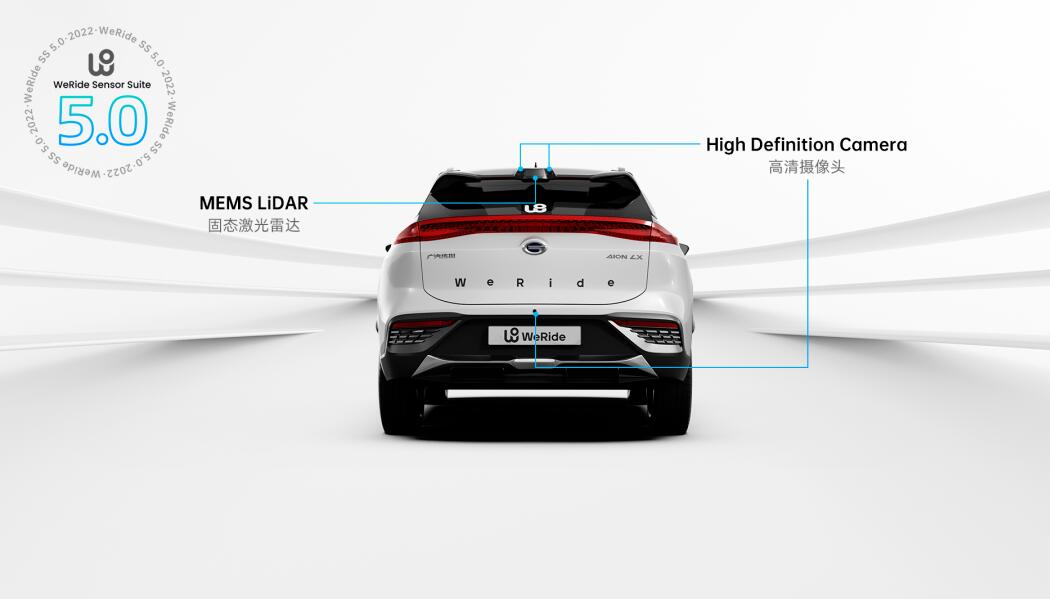WeRide unveils smaller, lower-cost self-driving sensor suite
WeRide SS 5.0 runs stably on all platforms with 250-500 TOPS of computing power, further lowering the threshold for Robotaxis, WeRide said.

(Image credit: WeRide)
The high price of sensor suites is one of the major factors holding back the commercialization of autonomous driving technology, and many companies are working to solve this issue.
Chinese self-driving startup WeRide today announced the release of WeRide Sensor Suite 5.0 (WeRide SS 5.0), a next-generation self-driving sensor suite that boasts of making autonomous driving capabilities available to different vehicle models with greater efficiency and lower cost.
The suite will accelerate the mass production and commercialization of WeRide's Robotaxi, the company said, without disclosing the exact cost.
WeRide's local counterpart DeepRoute announced its L4 autonomous driving solution DeepRoute-Driver 2.0 on December 8 last year, claiming better performance than Tesla's FSD (Full Self-Driving) and a price tag of less than $10,000, the lowest on record for the industry.
On April 20, DeepRoute announced the first fleet with the solution, consisting of 30 vehicles that will be put into the company's Robotaxi operation in Shenzhen.
Back to WeRide, its WeRide SS 5.0 has 12 cameras, seven solid-state MEMS LiDARs that make up 6 perception modules, laid out in different locations on the body.



The design allows the self-driving kit to truly integrate with the car, maximizing the original shape of the body while achieving powerful sensing capabilities across the board, according to WeRide.
The seven solid-state LiDARs are located on the roof, rear wing and around the body, dramatically reducing the size of the kit and providing greater reliability, according to the company.
Thanks to further optimization of the solid-state LiDARs and the computing platform, WeRide SS 5.0 is stable on computing platforms with 250-500 TOPS of power, further lowering Robotaxi's computing threshold, the company said.
Compared to the previous generation sensor suite, WeRide SS 5.0 is further reduced in size and weight, with a 66 percent reduction in the height of the top front sensing module, a 15 percent reduction in thickness, and a 17 percent reduction in overall weight, it said.

WeRide SS 5.0 brings to the vehicle a sensing capability with a radius of more than 200 meters and 360° around the body, thus enabling stable handling of the increasingly complex Chinese urban traffic conditions, the company said.

Notably, while WeRide used mechanical LiDARs in its previous autonomous driving suite, WeRide SS 5.0 marks a shift in the company's choice of LiDARs to solid-state LiDARs.
WeRide SS 5.0 further demonstrates WeRide's L4 autonomous driving potential and strikes a breakthrough balance of autonomous driving performance, adaptability, and volume production cost control, it said.
Founded in 2017 and with global headquarters in Guangzhou, WeRide has accumulated more than 11 million kilometers of open road autonomous driving and more than 2.8 million kilometers of fully unmanned autonomous driving.
The company's products include Robotaxi, Mini Robobus, Robovan, Robo Street Sweeper and L2-L4 advanced smart driving solutions.
On December 14, 2021, GAC announced that it will invest $30 million in WeRide through its subsidiary.
In late March, tech media outlet LatePost reported that WeRide closed a new round of over $400 million in funding, resulting in a post-investment valuation of $4.4 billion.

